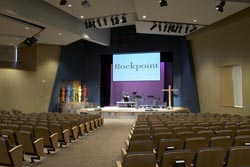Finding the right loudspeaker that fits into a church's budget and d�cor, like the system designed by AVE at the ornate Basilica of St. Mary in Minneapolis, can be a challenge.As we enter 2008, the house of worship segment is showing no sign of decline. Sensing an opportunity, many systems contractors and consultants are positioning their businesses to serve this vertical market-if they haven't already. But Monte Wise, director of special projects for Electro-Voice, warns that this is not a business move to be taken lightly. "It's hard to 'dabble' in the HOW market unless you concentrate and focus the right people and resources," he said. "The most successful contractors understand the needs that go beyond just choosing the right speaker or mixer, but provide insight, knowledge, and expertise to the project."
With that in mind, the beginning of a new year is a great time to take stock of technology trends, whether you're getting serious about courting the house of worship market or you're already entrenched in it. Lighting and speaker systems are mature technologies, but changing budgets and worship styles mean that customer needs are in flux. And manufacturers still find ways to innovate year after year.
Need a Line Array?
Your typical client at a house of worship is a technical director who pays close attention to technology trends and to what the marquee congregations are doing. Naturally, he or she has heard a lot about line array systems. "If you do a design/build or a consultant is brought into the project," Wise said, "my gut says that 75 percent or more would say that they need or want a line array." Especially, he says, as smaller and more affordable line array systems are introduced. For houses of worship, does the practical utility of powerful-and expensive-line array systems match their hype?

Lighting and speaker systems are mature technologies, but changing budgets and worship styles mean that customer needs are in flux.
Wise cites other potential line-array challenges, such as cost, possible interference with sight lines and architectural details, and the intense localization of amplified music that can sometimes drown out congregational singing. (Though he says that the increased labor costs associated with hanging more dispersed traditional systems can come close to erasing the cost premium of a line-array system.)
Rick Kamlet, senior market director for installed/commercial at JBL, says that the line-array phenomenon and its associated challenges have actually made consultants and clients more aware of pattern control, which in turn has helped everyone make smarter speaker choices. Of course, he notes, new line-array form factors continue to be introduced, so it's increasingly likely that a line array will fit a church's space and budget.
Room to Innovate
Speaker technology is certainly mature, but manufacturers are still finding ways to innovate. Audio consultants are taking notice as they design systems for houses of worship. Stefan Svard of Audio Video Electronics in Maple Grove, MN, mentions the continuing improvement in digital signal processing within the speaker box from manufacturers such as EAW, Renkus-Heinz, and Duran.
He also describes a more "organic" type of improvement that he's noticed and implemented in several houses of worship over the past year. Many manufacturers claim their 12-inch two-way speakers are time-aligned, but Svard has found that that's true only if you're lined up directly with the horn. But in Danley Sound Labs' SH-50 12-inch box, he notes, low-frequency, mid, and high-frequency are all integrated into the same horn. "When you're on-axis you can measure it and test it and it's perfect, so to speak," Svard said. "If you go off-axis, it's still perfect because all the sound is emanating from that one point. The frequencies all get to you in the same time whether you're on-axis or off-axis, so the consistency of the sound is what is so improved." Svard added that the Danley model solves the bulk of problems that arise when you put two speakers next to each other, such as canceling and comb filtering.
Lighting Systems
Audio Video Electronics often designs and integrates lighting systems for houses of worship along with video and audio systems. "People talk about even sound coverage, and that's great, but you also need even lighting coverage," Svard said. He says that retrofit opportunities exist in many churches built as late as the seventies, when architectural lighting was often less carefully planned than in today's 3D software-assisted sanctuary designs.
